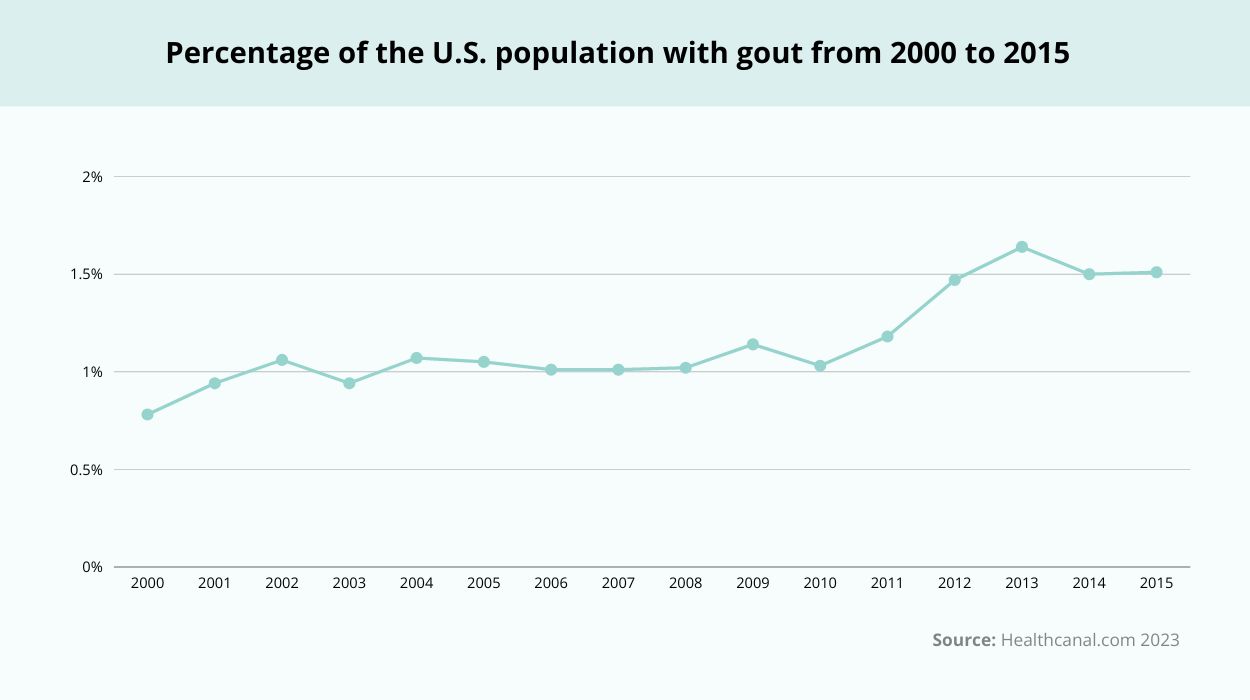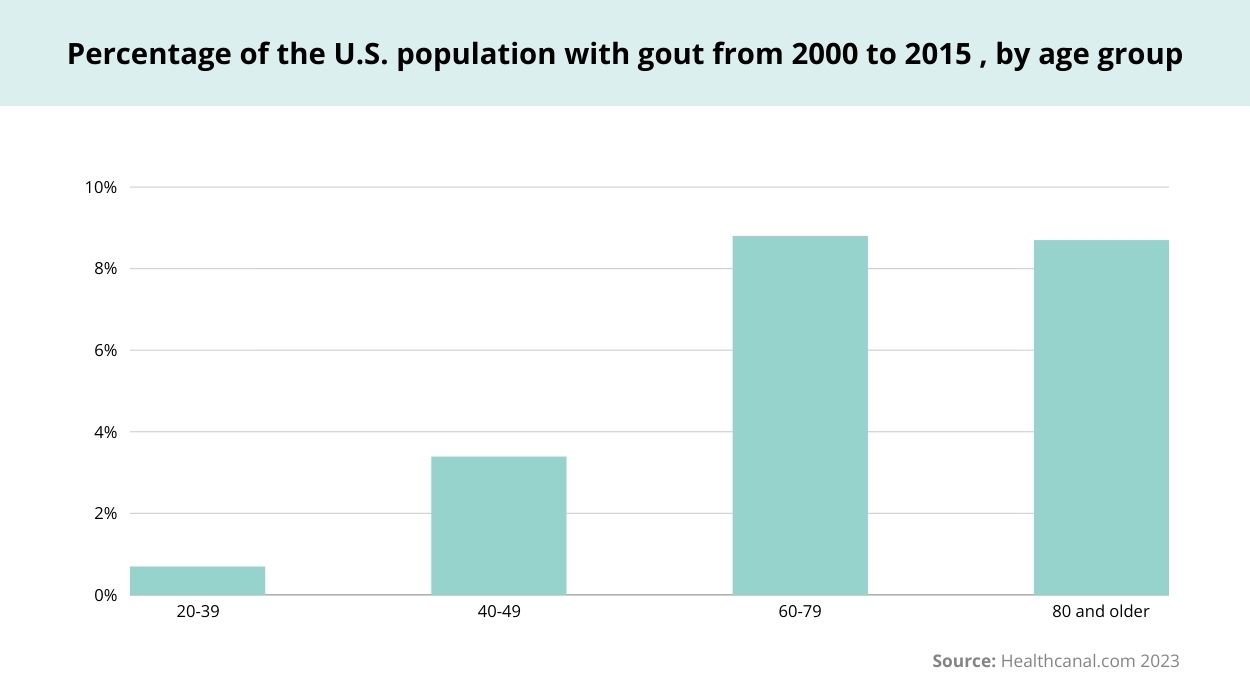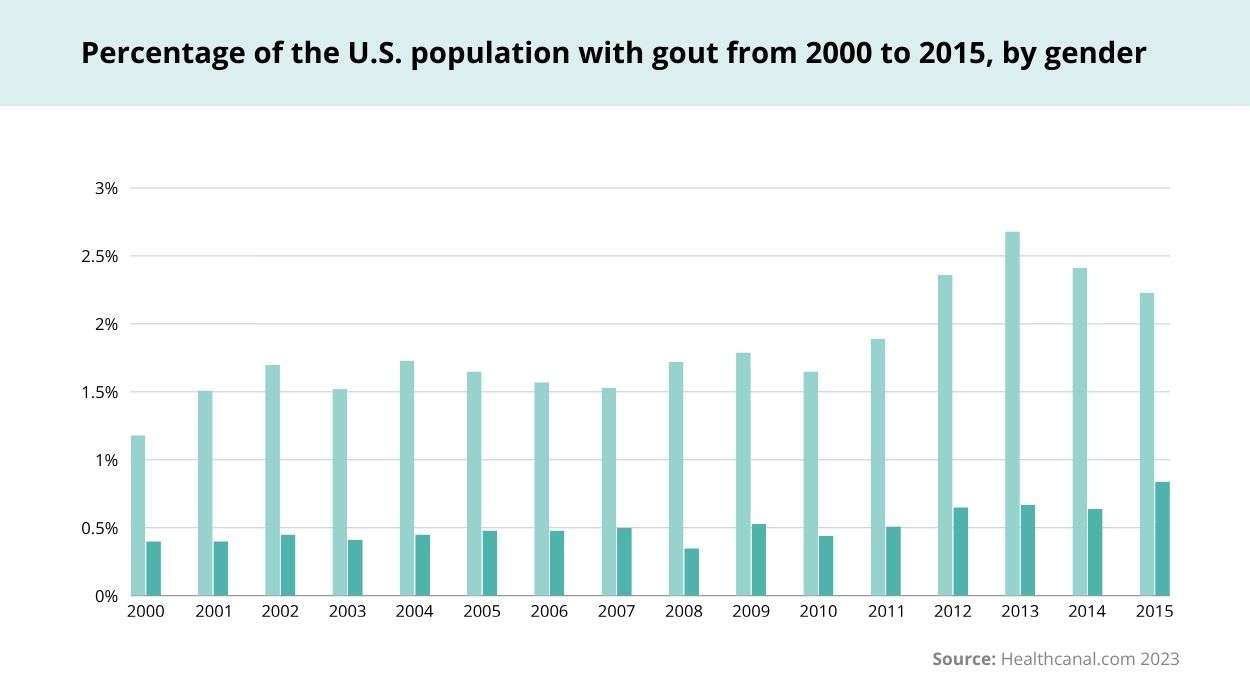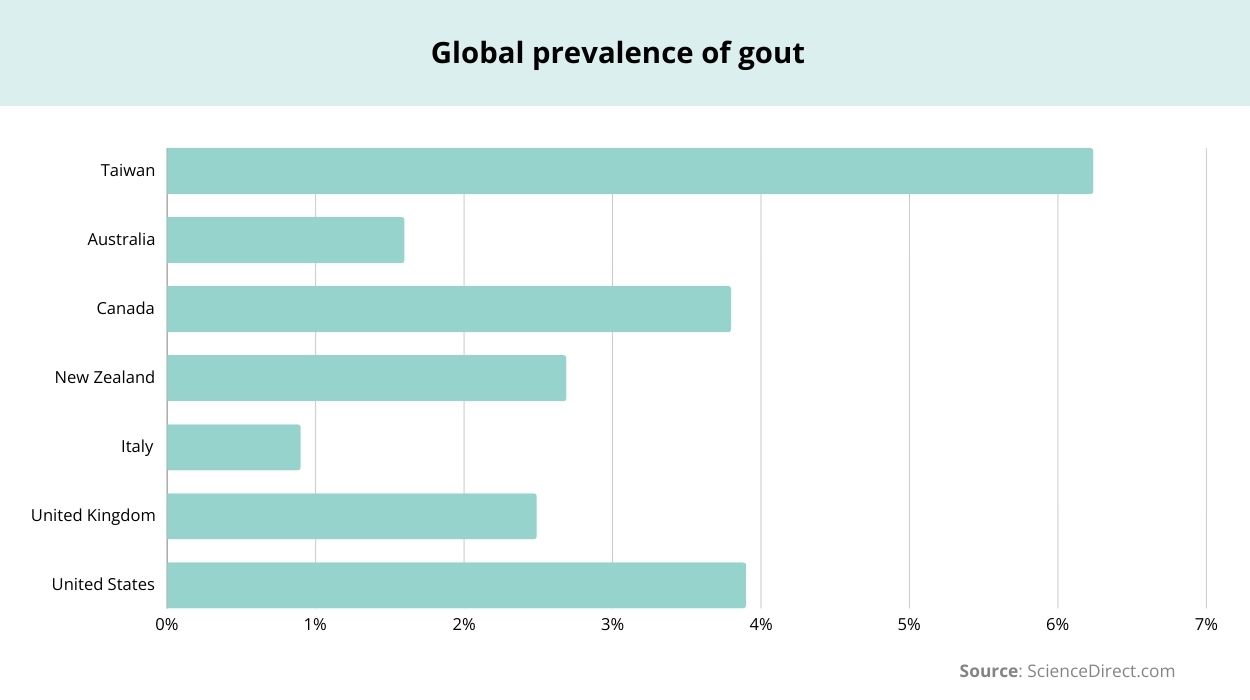 Evidence Based
Evidence Based
Evidence Based
This article is objectively based on relevant scientific literature, written by experienced medical writers, and fact-checked by a team of degreed medical experts.
Our team of registered dietitian nutritionists and licensed medical professionals seek to remain objective and unbiased while preserving the integrity of any scientific debate.
The articles contain evidence-based references from approved scientific sites. The numbers* in parentheses (*1,2,3) will take you to clickable links to our reputable sources.
Gout Statistics & Facts 2024 – Things You Need To Know

Gout is an inflammatory arthritic condition[1] that causes significant pain. Not everyone is aware of this condition or how common it is. Fortunately, national health statistics provide information about the prevalence of gout and who it affects.
Below, find data on the prevalence and incidence of gout, as well as information about risk factors for this disease.
You’ll also find information related to the treatment of gouty arthritis. While gout can cause significant pain and other health problems, it can be managed to improve quality of life.
Key Obesity Facts
- The incidence of gout in the U.S. was 123.93[2] new cases per 100,000 people aged 18-39 in 2019.
- As of 2015, 1.51%[3] of the U.S. population had gout.
- The same year, 2.23%[4] of men had gout, compared to 0.84%[4] of women.
- Non-Hispanic Blacks have the highest gout prevalence, at 4.8%.[5]
- Non-Hispanic Whites have a gout prevalence of 4.0%,[5] compared to 2.0%[5] in Hispanics.
Some of the most recent data show that the gout prevalence is as high as 5.1%[6] as of 2017-2018.
Gout Statistics In The United States

- As of 2000, 0.78%[3] of the United States population had gout. By 2015, this number rose to 1.51%.[3]
- Between 2000 and 2015, there were some declines in gout prevalence. For instance, between 2009 and 2010, prevalence dropped from 1.14%[3] to 1.03%.[3] By 2011, it climbed to 1.18%.[3]
- In 2013, the prevalence of gout was at 1.64%,[3] with a slight drop to 1.5%[3] in 2014.
While there have been some fluctuations, there has been a general trend toward increasing gout prevalence since 2000. Other research suggests that gout may be even more prevalent than demonstrated in the above graph. One study showed a prevalence of 3.9%[7] in U.S. adults from 2015-2016.
More recent data from 2017-2018 show that the prevalence of gout is as high as 5.1%[6] of the population. To put this into perspective, this means 12.1 million[6] Americans had gout in 2017-2018.
Results of a prevalence study show a significant increase[6] in gout from 2011-2012 to 2017-2018. Sometimes, increases in prevalence happen by random chance. However, gout increases are statistically significant, so we can conclude gout rates are rising in the U.S.
When viewing gout statistics, it’s helpful to understand that there can be variations in prevalence rates. When statisticians collect data, they take a sample of the population because it would be impossible to reach everyone. Sometimes, samples differ from each other, resulting in different rates across samples.
There is some variation in prevalence data, but experts seem to agree gout rates are increasing. According to Dr. Jennifer Silver, M.D., owner of Macleod Trail Dental, “There has been a subtle yet noticeable uptick in gout cases. While the increase isn’t solely attributed to a single factor, shifting dietary patterns, sedentary lifestyles, and even certain medications contribute to the rise.”
Who Gets Gout The Most
Gout Percentage By Age

- Among people aged 20-39, 0.7%[5] have gout.
- In those aged 40-49, the prevalence of gout is 3.4%.[5]
- In those 60-79 and 80 and older, the prevalence is 8.8%[5] and 8.7%,[5] respectively.
There is clearly an increased risk of gout in older age. Among those in their twenties and thirties, less than one percent have gout. In those aged 60 and above, the prevalence is almost nine out of 10.
Christine Kingsley, a U.S. Advanced Practice Registered Nurse (APRN) and Health and Wellness Director of The Lung Institute, explains why older adults are likelier to have gout. “There are multiple risk factors for gout. These include having certain conditions that are prevalent among older adults, such as high cholesterol, diabetes, and high blood pressure,” she says.
Kinglsey goes on to explain, “Kidney disease and reduced kidney function are also other risk factors, which are common among adults. Also, older adult men tend to be at the highest risk, along with post-menopausal women, because of the lack of estrogen, which is a natural protection against gout.”
Dr. Praveen Guntipalli, M.D., of the American Board of Internal Medicine and Obesity Medicine, agrees. “The elderly are more prone to gout due to the natural decline in kidney function, which impairs uric acid elimination, “ she states.
Gout risk factors exist more often in older adults, explaining their increased prevalence of gout. Chronic kidney disease, in particular seems to elevate risk in older adults, according to experts.
Gout Percentage By Gender

- As of 2015, 2.23%[4] of men and 0.84%[4] of women had gout.
- Gout prevalence in men reached a peak of 2.68%[4] in 2013.
- Women reached a peak prevalence of 0.84%[4] in 2015.
Men have consistently demonstrated higher rates of gout than women. While from a different dataset, more recent statistics on the prevalence of gout also show a higher prevalence in men.
Data from the National Health and Nutrition Examination Survey show that in 2015-2016, 5.2%[5] of men had gout. In comparison, 2.7%[5] of women had gout at this time.
International Gout Prevalence

- Among the countries above, Taiwan has the highest prevalence of gout, at 6.24%.[8]
- The United States has the second highest prevalence, at 3.90%.[8]
- Canada’s prevalence of gout is comparable to the rate seen in the U.S., at 3.80%.[8]
- Italy has comparatively low rates of gout, at 0.90%.[8]
According to a study on international gout prevalence, the rate of gout varies by country. The sources of the data include things like a national survey or national health claims database.
There is some variation in data collection methods among different countries. However, this study provides insights into the global variation in the prevalence of gout.
Based on available data, rates of gout are highest in Taiwan. The United States falls next behind Taiwan but with a noticeably lower gout prevalence. Italy has the lowest prevalence among all countries in the study, possibly due to their high intake of fruits and vegetables and low intake of purines.
Gout Facts To Know
The above statistics provide information about the prevalence of gout, but there are other facts to know. The following sections provide additional information about gout epidemiology.
Gout Incidence Is Increasing In Young People.
Gout prevalence data show that older adults are the most likely to have gout. However, data show a rising incidence in younger populations.
Prevalence refers to the percentage of people in the population with a condition at a given time. On the other hand, incidence refers to new cases of a condition identified during a given time period.
Statistics show gout incidence has increased in the U.S. among people aged 15-39. In 1990, the incidence was 76.34[2] cases per 100,000 people in this age range. By 2019, the incidence increased to 123.93[2] cases per 100,000 people.
Certain Regions Have Seen Larger Increases In Gout Incidence Among Young People.
The increase in gout incidence among people aged 15-39 has been highest in North America. In 1990, there were 77.4[2] new cases of gout per 100,000 people in this age range in North America. By 2019, the incidence rose to 122.72[2] cases per 100,000 people.
East Asia had the second highest increase in gout incidence among those aged 15-39. In 1990, gout incidence in East Asia was 55.46[2] new cases per 100,000 people of this age. As of 2019, the incidence rose to 80.07[2] cases per 100,000 people.
Maldives Has Experienced Large Increases In Gout Incidence In Young People.
Gout epidemiology shows that Maldives has had the largest increase in gout incidence among those aged 15-39. In 1990, there were 39.14[2] new cases per 100,000 people of this age in the population. As of 2019, there were 84[2] cases per 100,000 people.
The U.S. still has a larger gout incidence than Maldives, with 123.93[2] cases per 100,000 people aged 15-39. However, Maldives has had a larger increase in gout incidence between 1990 and 2019.
Prevalence Of Gout Varies Based On Race/Ethnicity.
According to data from the U.S. in 2015-2016, there are variations in gout prevalence by race/ethnicity. The prevalence in non-Hispanic Whites is 4.0%,[5] compared to 4.8%[5] in non-Hispanic Blacks. In Hispanics, the prevalence is 2.0%.[5]
Among those of other races/ethnicities, 5.2%[5] have gout. One recent study found that as of 2017-2018, the prevalence of gout in Asian Americans was 6.6%.[6]
Hyperuricemia Is Much More Common Than Gout.
Hyperuricemia, which refers to high uric acid levels, causes gout. However, not everyone who has this condition develops gout. As of 2015-2016, 20.02%[6] of men and 20.0%[6] of women had hyperuricemia.
Gout Prevalence Is Increasing Around The Globe.
According to global epidemiology, gout has become more common. Across the globe, the incidence of gout has increased by 63.44%[9] in the last two decades. In nations with a higher socioeconomic status, incidence increased by 94.3%.[9]
Globally, gout incidence increased in both men and women over the last two decades. However, the ratio of gout incidence remains 3:1,[9] for men vs. women.
Weight Gain Is A Significant Risk Factor For Gout.
There is a strong relationship between obesity and gout. According to a study[10] on risk factors, the highest risk of developing gout is among people who remain obese. Furthermore, gaining weight over a 10-year period increases gout risk by 65%.[10]
The link between gout and weight is pretty strong. In fact, if the population maintained a healthy BMI, 32.9[10] of new gout cases could be prevented.
Earlier research has shown that gout prevalence is 1-2% in people with a healthy BMI. In those with an overweight BMI, prevalence jumps to 3%.[11]
Among those with class one obesity, defined[12] as a BMI of 30 to less than 35, gout prevalence is 4-5%.[11] Class two and three obesity are defined[12] as a BMI of 35 to less than 40 and over 40, respectively. In this group, gout prevalence ranges from 5-7%.[11]
Gout Causes Significant Disability Across The Globe.
Public health experts refer to “years lived with disability” or YLD when talking about the burden of disease. Between 1990 and 2019, the global YLD from gout increased 51.12%.[9]
In 1990, the global YLD from gout was 0.69 million.[9] By 2019, it rose to 1.67 million.[9]
What Is Gout
Gout[1] is a type of inflammatory arthritis, and it’s rather common. This type of arthritis most often affects the big toe.
When a person has gout, they experience[1] gout flares. During a gout flare, the affected joint becomes very painful. After a flare, a person can enter remission. This means they do not experience any symptoms of gout.
Repeated gout flares can lead to the development[1] of gouty arthritis. This is a type of arthritis that gets worse over time.
What Causes Gout
Gout[1] is caused by a condition called hyperuricemia, which develops when the body’s levels of uric acid are too high. Uric acid levels rise when the body breaks down substances called purines.
When uric acid levels are too high, uric acid crystals accumulate in joints and other tissues in the body. It’s possible to have too much uric acid without having gout. However, high uric acid increases gout risk.
Gout is sometimes called podagra.[13] The Ancient Greeks first noticed gout in the big toe, and they called the condition “podagra.” This term means “foot grabber,” and as such, podagra became a suitable name for gout.
During gout flares, joints become swollen and hot. If gout is suspected, lab work is performed. A person who has gout will show evidence of uric acid crystals within the affected joint.
Risk Factors For Gout
Developing gout is more likely when a person has risk factors for the condition. Elevated uric acid is the direct cause of gout, but risk factors increase the chance that a person will develop gout.
Risk factors for gout include:[1]
- Dietary factors like eating large amounts of red meat, organ meat, and seafood including tuna, scallops, sardines, and anchovies.
- Consuming large amounts of fructose, which is found in soda and candy.
- Drinking large amounts of alcohol.
- Using medications like diuretics.
- Being obese.
- Being male.
- Having other health conditions, like insulin resistance, metabolic syndrome, high blood pressure, congestive heart failure, and chronic kidney disease.
Gout Symptoms
When people have gout, they experience gout flares. However, they also experience periods of remission with no symptoms.
During gout flares, a person will experience the following symptoms:[1]
- Intense pain in the affected joint.
- Swelling of the joint.
- Redness.
- A hot sensation in the affected joint.
Problems Associated With Gout
It’s important to take steps to manage gout symptoms to reduce the risk of complications. Research[14] has shown that gout increases the risk of death from heart disease, kidney disease, and digestive diseases.
While the overall mortality rate isn’t higher in gout, women with gout are at 10% increased risk[14] of death. Furthermore, hypertension and chronic kidney disease are common[8] in people with gout. Death from kidney disease is 53%[14] more likely among those with gout.
Gout Treatment
Treatment of gout involves a combination of pain management, medication, lifestyle changes, and dietary interventions. As Dr. Guntipalli explains, “Successful gout management involves a holistic approach, including medications to control uric acid and lifestyle interventions like dietary modifications, maintaining a healthy weight, and avoiding known triggers such as alcohol and certain foods.”
These various interventions for gout are described in more detail below.
Pain Management And Medication For Gout
Treatment for gout often focuses on managing the pain associated with a gout flare. Gout patients may use[1] nonsteroidal anti-inflammatory drugs, such as ibuprofen or acetaminophen, to manage symptoms. Some patients may benefit from corticosteroid injections.
Gout patients who have frequent flares may benefit from urate-lowering therapy. Drugs, including[1] allopurinol, febuxostat, and pegloticase, lower uric acid levels and can prevent gout flares.
Lifestyle Changes For Gout
Other treatment strategies involve making lifestyle changes to prevent flare-ups. Avoiding medications like diuretics can reduce the risk of a gout flare. It can also be helpful to avoid alcohol and high-purine foods, including red meats and organ meat.
It’s also important to make changes to your exercise habits. Moderate-intensity physical activity, such as walking, can help manage gout. Exercise can reduce[15] inflammation, leading to better outcomes for gout patients.
Dietary Interventions For Gout
Additional dietary changes that can be helpful include[16] reducing fat and sugar intake, as high intake can worsen symptoms. High amounts of animal protein can also cause uric acid stones to form. So, you should choose plant and dairy protein instead.
Gout patients should also increase[16] their intake of fruits and vegetables, which are rich in vitamins and minerals. Increasing fiber intake is also recommended[16] for gout management.
The goal of a gout diet is to help you lose weight[17] since a high BMI is correlated[18] with higher uric acid levels. In addition to other changes discussed here, drinking enough water[18] and avoiding high-fructose corn syrup is important. These strategies reduce the risk of metabolic syndrome and can prevent future gout flares.
Medical research has shown that excessive fructose intake can increase uric acid levels, according to Dr.Silver. “Excessive fructose intake, often found in sugary beverages and processed foods, has been linked to elevated uric acid levels. This less-explored avenue provides a nuanced perspective on dietary factors influencing gout development,” she says.
Jabe Brown, BHSc, MSc, owner of Melbourne Functional Medicine, agrees that diet and lifestyle play a role in managing gout. “In addition to medical treatment, lifestyle adjustments can help manage gout,” he says, adding that this includes keeping the body hydrated and avoiding alcohol and high-purine foods.
The experts agree that diet is important for treating gout symptoms. If you have gout, it’s important to follow your doctor’s advice and make dietary changes to improve your prognosis. Untreated gout can be painful and disabling, but the condition can be managed.
Conclusion
According to the latest statistics, gout prevalence seems to be increasing in the United States. Men are more likely than women to be affected, and non-Hispanic Blacks have a higher prevalence compared to other races.
When untreated, gout can lead to significant pain and other health complications, like heart disease. Fortunately, gout can be managed with medication and lifestyle changes.
Frequently Asked Questions
Research shows that gout increases the risk of kidney, cardiovascular, and digestive diseases. All of these can increase the risk of premature death. However, you can manage gout and live a long life with this condition.
With treatment and lifestyle interventions, you can reduce the risk of gout flares. This can prevent chronic disability from gout.
Moderate-intensity exercise has been identified[15] as helpful for managing gout. Regular walking could reduce inflammation and lead to a better prognosis.
Foods containing fructose, including candy and soda, can worsen gout. Purine-containing foods, such as red meat, organ meat, and certain types of seafood, can also cause gout flares.
+ 18 sources
Health Canal avoids using tertiary references. We have strict sourcing guidelines and rely on peer-reviewed studies, academic researches from medical associations and institutions. To ensure the accuracy of articles in Health Canal, you can read more about the editorial process here
- Anon, (2023). Gout. [online] Available at: https://www.cdc.gov/arthritis/types/gout.html [Accessed 27 Nov. 2023].
- Zhang, J., Jin, C., Ma, B., Sun, H., Chen, Y., Zhang, Y., Han, C., Liu, T. and Li, Y. (2023). Global, regional and national burdens of gout in the young population from 1990 to 2019: a population-based study. RMD Open, [online] 9(2), pp.e003025–e003025. doi:https://doi.org/10.1136/rmdopen-2023-003025.
- (2015). Gout prevalence U.S. 2000-2015 | Statista. [online] Available at: https://www.statista.com/statistics/981262/gout-prevalence-us/
- (2015). Gout prevalence by gender U.S. 2000-2015 | Statista. [online] Available at: https://www.statista.com/statistics/981316/gout-prevalence-us-by-gender/
- Chen-Xu, M., Chio Yokose, Sharan, K., Pillinger, M.H. and Choi, H.K. (2019). Contemporary Prevalence of Gout and Hyperuricemia in the United States and Decadal Trends: The National Health and Nutrition Examination Survey, 2007–2016. Arthritis & Rheumatology, [online] 71(6), pp.991–999. doi:https://doi.org/10.1002/art.40807.
- Chio Yokose, McCormick, N., Lu, N., Sruthi Tanikella, Lin, K., Joshi, A.D., Raffield, L.M., Warner, E.T., Merriman, T.R., Hsu, J., Saag, K.G., Zhang, Y. and Choi, H.K. (2023). Trends in Prevalence of Gout Among US Asian Adults, 2011-2018. JAMA network open, [online] 6(4), pp.e239501–e239501. doi:https://doi.org/10.1001/jamanetworkopen.2023.9501.
- Singh, G., Bharathi Lingala and Alka Mithal (2019). Gout and hyperuricaemia in the USA: prevalence and trends. Rheumatology, [online] 58(12), pp.2177–2180. doi:https://doi.org/10.1093/rheumatology/kez196.
- Singh, J.A. and Gaffo, A.L. (2020). Gout epidemiology and comorbidities. Seminars in Arthritis and Rheumatism, [online] 50(3), pp.S11–S16. doi:https://doi.org/10.1016/j.semarthrit.2020.04.008.
- He, Q., Tsz Ngai Mok, Sin, T., Yin, J., Li, S., Yun Ju Yin, Ming, W. and Feng, B. (2023). Global, Regional, and National Prevalence of Gout From 1990 to 2019: Age-Period-Cohort Analysis With Future Burden Prediction. JMIR public health and surveillance, [online] 9, pp.e45943–e45943. doi:https://doi.org/10.2196/45943.
- Bai, L., Zhou, J., Zhou, T., Newson, R. and Marly Augusto Cardoso (2021). Incident gout and weight change patterns: a retrospective cohort study of US adults. Arthritis Research & Therapy, [online] 23(1). doi:https://doi.org/10.1186/s13075-021-02461-7.
- Juraschek, S.P., Miller, E.R. and Gelber, A.C. (2012). Body mass index, obesity, and prevalent gout in the United States in 1988-1994 and 2007-2010. Arthritis Care & Research, [online] 65(1), pp.127–132. doi:https://doi.org/10.1002/acr.21791.
- CDC (2022). Defining Adult Overweight & Obesity . [online] Centers for Disease Control and Prevention. Available at: https://www.cdc.gov/obesity/basics/adult-defining.html
- Ganesh Avhad and Priyanka Ghuge (2014). Podagra. Indian Dermatology Online Journal, [online] 5(6), pp.134–134. doi:https://doi.org/10.4103/2229-5178.146196.
- Dehlin, M., Tatiana Zverkova Sandström and Jacobsson, L. (2022). Incident Gout: Risk of Death and Cause-Specific Mortality in Western Sweden: A Prospective, Controlled Inception Cohort Study. Frontiers in Medicine, [online] 9. doi:https://doi.org/10.3389/fmed.2022.802856.
- Jablonski, K., Young, M., Henry, C., Caution, K., Anuradha Kalyanasundaram, Okafor, I., Harb, P., Schwarz, E., Consiglio, P., Cirimotich, C.M., Bratasz, A., Sarkar, A., Amer, A.O., Jarjour, W. and Schlesinger, N. (2020). Physical activity prevents acute inflammation in a gout model by downregulation of TLR2 on circulating neutrophils as well as inhibition of serum CXCL1 and is associated with decreased pain and inflammation in gout patients. PLOS ONE, [online] 15(10), pp.e0237520–e0237520. doi:https://doi.org/10.1371/journal.pone.0237520.
- Zhang, Y., Chen, S., Yuan, M., Xu, Y. and Xu, H. (2022). Gout and Diet: A Comprehensive Review of Mechanisms and Management. Nutrients, [online] 14(17), pp.3525–3525. doi:https://doi.org/10.3390/nu14173525.
- Chio Yokose, McCormick, N. and Choi, H.K. (2021). Dietary and Lifestyle-Centered Approach in Gout Care and Prevention. Current Rheumatology Reports, [online] 23(7). doi:https://doi.org/10.1007/s11926-021-01020-y.
- Líška D (2021). Non-pharmacological treatment of gout. Vnitrni lekarstvi, [online] 67(E-2). Available at: https://pubmed.ncbi.nlm.nih.gov/34074101/



